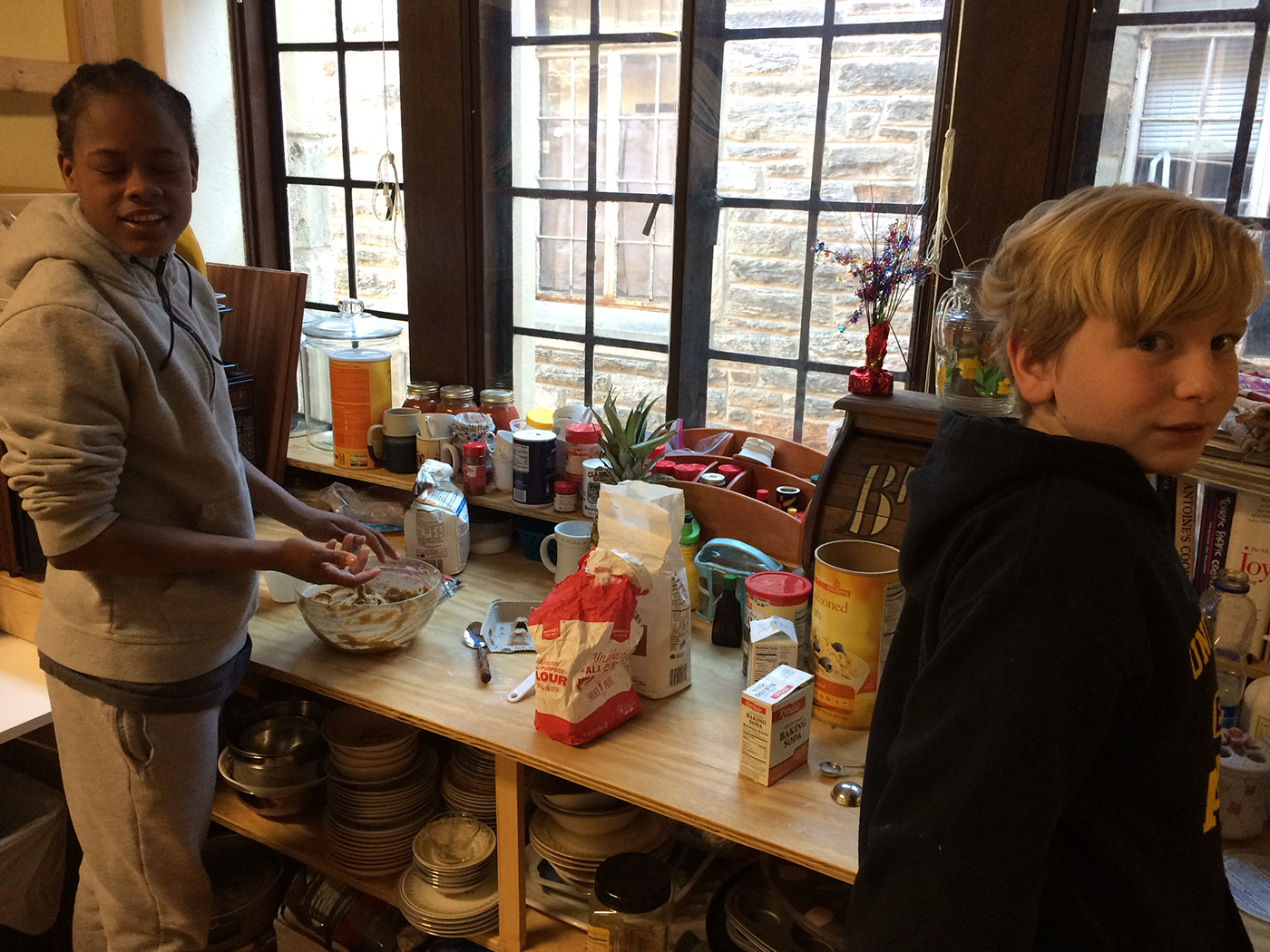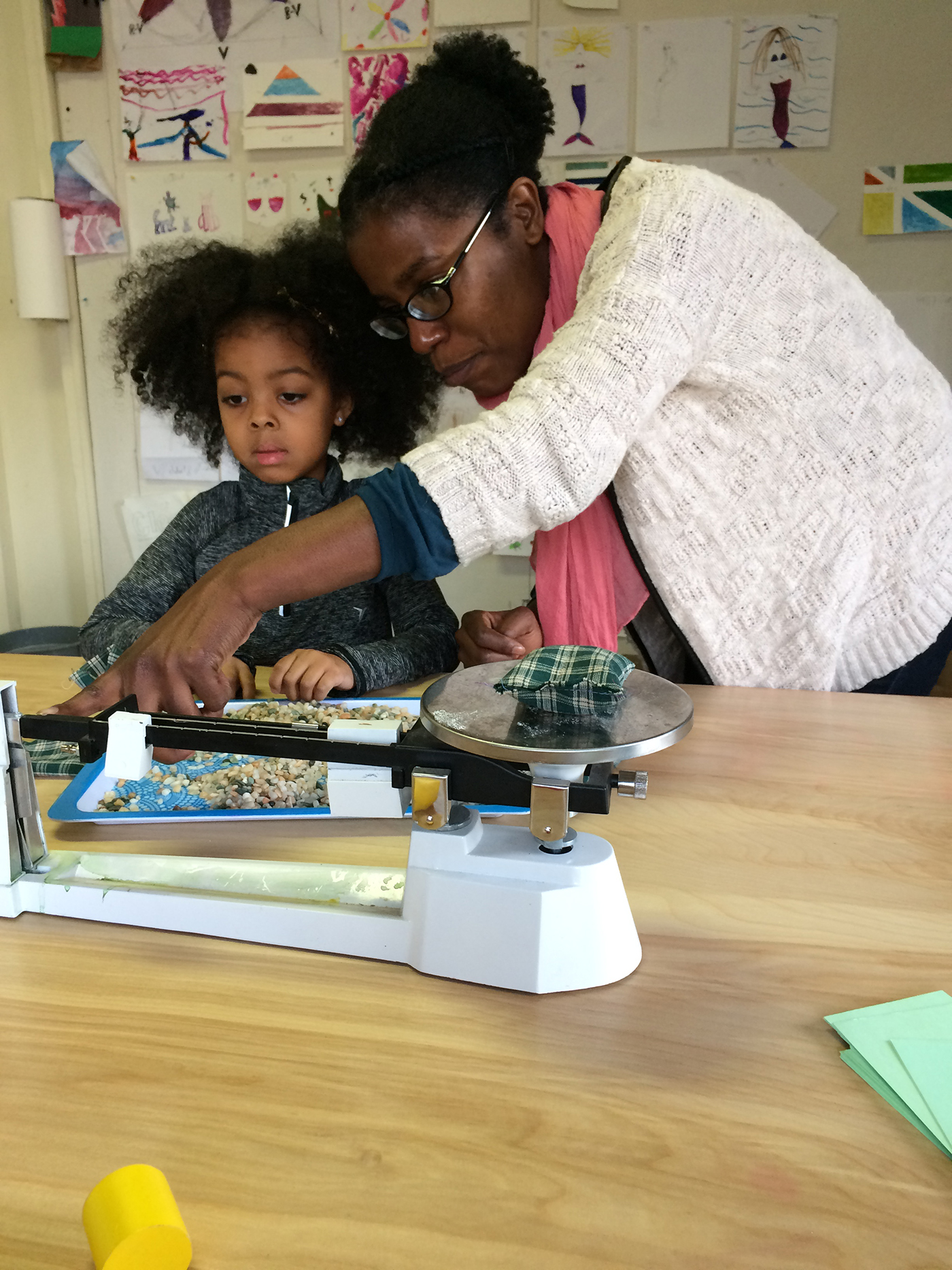
Real life and academic skills are both developed in such hands-on activities as cooking, best enjoyed as a collaborative process.
Photo Credit: NCC
It is generally acknowledged that we humans are naturally wired and self-motivated to learn. This is most evident during the first three years of life. Watch a toddler master walking and talking -- the latter being one of the most complex skills we ever develop -- and you will see living proof. There is no need to be coerced, bribed, or bullied. In fact, such actions on the part of well-intentioned adults tend to disrupt the process, sometimes with longstanding consequences such as loss of self-confidence or self-limiting beliefs and maladaptions. Unfortunately, the same can be said for compulsory schooling, where the combination of standardized curricula and uninvited instruction on a prescribed schedule tend to lead to the development of compensating mechanisms (such as memorization in lieu of comprehension) as well as boredom and a lack of initiative. It should come as no surprise that we have, as author/educator John Holt said, “so much fakery at the top and failure at the bottom,” in our schools and in society in general.
At the Natural Creativity Center (NCC) in Philadelphia, PA, we see no reason to override the natural process of self-motivated and self-directed, learning and personal development just because someone has turned five. We offer young people the same loving support and access to enticing resources as any nurturing parent does initially. They enjoy the freedom to explore at will, trusting in their innate abilities to learn and grow and figure things out. They have the right to pursue their interests at their own pace within the bounds of respect for others. No imposed curriculum (especially a standardized one), no grades, no tests, no uninvited instruction -- just a stimulating physical environment consisting of various work/play spaces, tools, books, materials, and interested and interesting peers and adults ready and willing to assist at the youth’s request.

Adults are always available to help with the use of real-life tools and instruments, such as this balance, when it is requested by a youth. Here, careful measurement ensures that each bean bag will weigh the same after being filled and hand-sewn shut.
Photo Credit: NCC
“Learning is not the product of teaching,” remarked author/educator John Holt (How Children Fail, Pitman,1964, and in talks). “Learning is the product of the “activity of the learner.” At NCC, life is all about activity -- exploring, experimenting, questioning, designing, building, testing, reading, talking, collaborating, imagining, drawing, writing, cooking, and dissecting.
Young people ages four through 17 attend anywhere from one to four days each week as an alternative to being enrolled in a school. Those of compulsory school age, which in Pennsylvania is age eight, register in their district as “homeschoolers.” Participation at NCC is thus one aspect of their education -- a term that we define as the “internal” process that leads to understanding and skill development, not as the receipt of an “external” product that is largely memorized, regurgitated, and forgotten, hopefully not until after the final exam. The youth at NCC are free to pursue their individual and collective interests as they go about figuring out how the world works and finding their place in it. The so-called “basics” are just as much a part of life’s curriculum as walking and talking. Hence, one might learn fractions off of a measuring tape in the woodshop just as likely as from use of a measuring cup in the kitchen; they may be introduced to the presidents from a coin collection as well as read about them in storybooks or biographies; and get inspired to conduct chemistry experiments from watching a YouTube video as joining a demonstration offered by a visiting college student or professional scientist. No need for assigned reading from textbooks here.
At the same time, The Natural Creativity Center does have a certain agenda on behalf of our young people. We asked ourselves, “What is the preferred role for adults in the lives of the young” beyond the obvious provision of basic safety, food, shelter, etc., and “What do we want to be sure is nurtured in them to increase the probability that they will grow to live lives of purpose and fulfillment.” Our conclusion is known in-house as “The Three C’s,”, representing Creativity, Compassion, and Collaboration. We see the absence of these attributes as lying at the heart of “man’s inhumanity toward man,” and thus indicating how we can best solve the world’s biggest challenges by fostering them through what we call “Process Consciousness.” Becoming aware of which behaviors most often increase people’s probability of success with regard to our universal set of needs -- those being the need for safety and security, a sense of autonomy, as well as a sense of belonging/connectedness, a sense of competence and a sense of pleasure/fun -- and which behaviors decrease our probability of success, has far more impact than the awareness of any collections of content data.
By Creativity, we mean, first, the ability to bring into being something that does not yet exist (for example, a dollhouse, a business plan, a delicious meal); and second, the concept of novelty -- something that is new and different from what has previously existed (a new theory, a paradigm-shifting product). Both forms of creativity meet our need for a sense of personal competency; they instill a “can do” sense of ourselves, in marked contrast to the learned helplessness that is so prevalent in so many people today, “I can’t find a job,” “I’m not smart enough to be my own boss,” or “I could never learn to cook.”
At NCC we encourage youth to open up their imaginations when faced with challenges of any sort with “How-to” statements that capture the full range of their initial thinking. For example, “How to have a garden when I have no yard” might lead to “How to borrow a neighbor’s yard, How to grow vegetables in small spaces, How to turn my porch into a yard, How to put a yard on my roof, How to grow vegetables without a yard, How to suspend a garden in the air,” and more. Secondly, as newborn ideas begin to emerge, we encourage the use of what we call “Balanced Responses:” first state at least three positives to an idea, reasons why it’s a good one; then consider its shortcomings as “holes-to-be-filled,” and state them individually, again as “How-to’s,” such as “How to get a supply of half-barrels for free.” Fill the holes one at a time until the idea is feasible and you know what next steps to take to implement it. This is a possible solution that can then be pursued. The key element here is to replace the conventional “That’s a good idea but…” response with the more constructive balanced response. Novel ideas can be ignited by learning to use analogies that introduce more imaginative ideas, another technique that we share.
Our second C-- Compassion -- is the ability to see life from the perspective of others and to place the satisfaction of their needs alongside our own. Simple paraphrasing, “What is your understanding of what Chris is saying?” goes a long way in this direction. Marshall Rosenberg’s book Non-violent Communication goes several steps further and has helped us show the value of accepting other people’s feelings and needs, then seeking strategies for meeting both their needs and our own in the same conversation. If everyone validates one another’s needs, such compassion calls out for a collaborative resolution that is mutually satisfying. For example, it is easier for me to accept your need to celebrate, for example, if I know that you accept my need for sleep. Let’s work together for a win-win solution.
That, of course, is the third C -- Collaboration -- during which you and I, working together, create solutions that are better than what either of us might propose alone. They are better because both parties’ needs are satisfied without a conflict, and the diversity of our perspectives can spark more imaginative ideas in one another’s thinking. “Hey, when you said ‘light,’ that gave me the image of a row of street lamps. What if we organized our work in rows instead of doing everything randomly?” Such crediting of others can increase the probability of having our newborn ideas be listened to. Even more helpful is when we give balanced responses to one another’s offers and help each other fill the “holes” in undeveloped ideas. The emerging possible solutions thus become “ours” rather than yours or mine; we are both now invested in making them work.
The last component of the NCC approach to mention here is the concept of “Partnership Education.” For us, that means sharing the goals of all three parties -- the youth, first and foremost, because it’s their lives; then the parents, and then the NCC staff. Each family meets with a staff partner regularly to tell what they wish to get out of their NCC experience, while the staff facilitates the creative process of identifying ways to support the identified interests. Conversations overheard include:
“Oh, you want to learn more about certain animals? What ideas do you already have about how to do that, and where would you like help? Find an internship or bring in a Visiting Artist who specializes in that area…sure, we can do that." Or, "You want to learn a foreign language…how do you imagine you would like to do that? With an instructor or on your own using videos or listening to songs or maybe start with bilingual picture books and a pen pal from the appropriate country who wants to get better in English?”
The on-going conversation involves a create-and-adjust process with the youth at the center and whatever support is called for from the partnering adults.
In sum, our goal at The Natural Creativity Center is to engage and expand the innate capabilities of young people to create the lives they want both now and in their future. By mastering the behaviors that reflect our human nature at its best -- our abilities to imagine, experiment and create; our desire to connect positively with others; and our preference for enjoyment in whatever we do -- our younger colleagues will be better able to address the biggest needs facing humankind today: how to stop fighting each other and overcome the challenges of hunger and threatening climate change. Life should be viewed as an opportunity, not as a problem to be overcome. If we learn to bring out the best in ourselves, and nurture that in others, life will become better for everyone.


